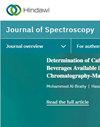CO2激光辐射下硅酸盐水泥水化机理的拉曼光谱研究
IF 2.1
4区 化学
Q4 BIOCHEMICAL RESEARCH METHODS
引用次数: 0
摘要
本研究展示了在不同的水灰比(W /c) 0.4、0.45和0.5下,用功率为1.6、2.0和2.4 W的CO2激光照射新鲜波特兰水泥浆的结果。拉曼光谱通过拉曼信号的强度变化显示了主要水化产物的演化和加速生长。拉曼位移表明,在较短的时间内检测到C-S-H, CH, AFt和CaCO3波段,这意味着凝结时间也缩短了。在磨矿过程中,石灰石掺入了碳酸钙,这表明碳酸钙是水泥水化过程中反应加速的主要原因。相对于辐照水泥浆体,未辐照水泥浆体水化产物的拉曼信号在其演化过程中呈现延迟。从拉曼光谱得到的曲线可以用来模拟水化机理和了解凝结过程。本文章由计算机程序翻译,如有差异,请以英文原文为准。
Study of the Hydration Mechanism of Portland Cement with Raman Spectroscopy Applying CO2 Laser Radiation
This work presents the results by irradiating fresh Portland cement pastes with CO2 laser, at powers of 1.6, 2.0, and 2.4 W, at different water-to-cement (w/c) ratios 0.4, 0.45, and 0.5. Raman spectra show the evolution and accelerated growth of the main hydration products through the intensity changes of the Raman signal. The Raman shifts reveal that the C-S-H, CH, AFt, and CaCO3 bands are detected in a shorter time, which means that the setting times are also reduced. The detected band of calcium carbonate, which is due to the incorporation of limestone during the grinding process, shows that it is responsible largely for the acceleration in the reactions during the hydration of the cement. The Raman signals of the hydration products of nonirradiated cement pastes present a delay in their evolution with respect to the irradiated pastes. The curves obtained from the Raman spectra can be used to model the mechanism of hydration as well as to understand the setting process.
求助全文
通过发布文献求助,成功后即可免费获取论文全文。
去求助
来源期刊

Journal of Spectroscopy
BIOCHEMICAL RESEARCH METHODS-SPECTROSCOPY
CiteScore
3.00
自引率
0.00%
发文量
37
审稿时长
15 weeks
期刊介绍:
Journal of Spectroscopy (formerly titled Spectroscopy: An International Journal) is a peer-reviewed, open access journal that publishes original research articles as well as review articles in all areas of spectroscopy.
 求助内容:
求助内容: 应助结果提醒方式:
应助结果提醒方式:


